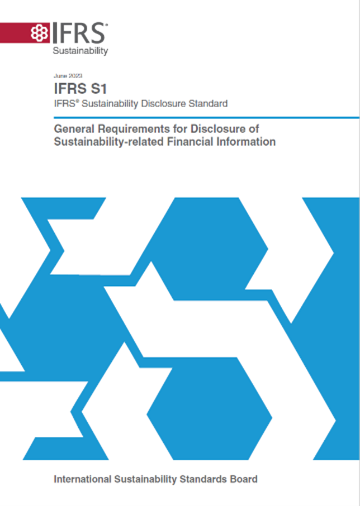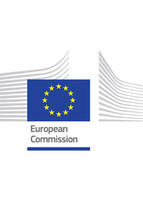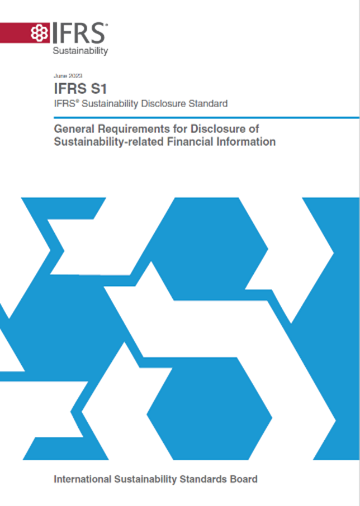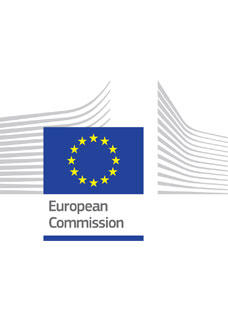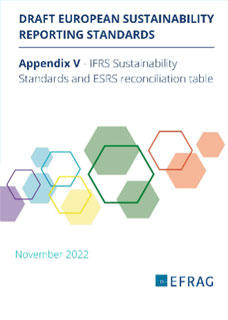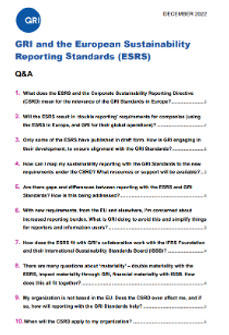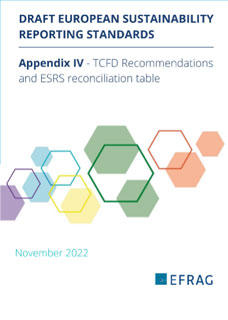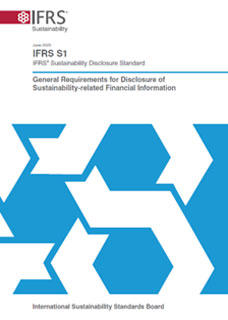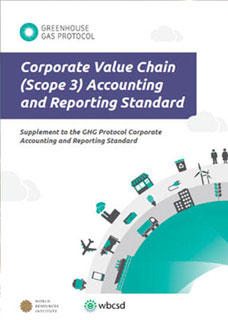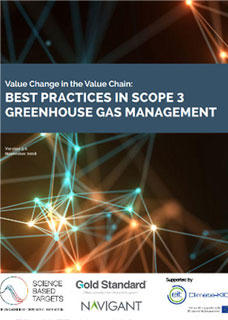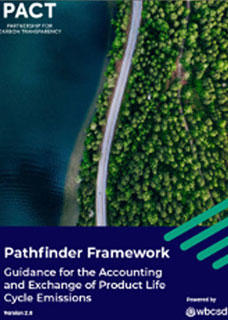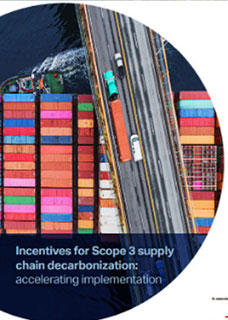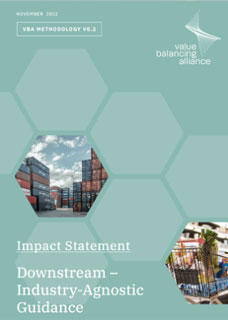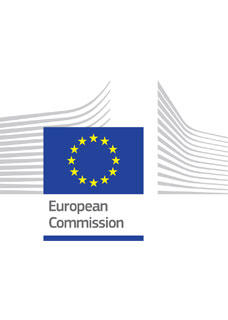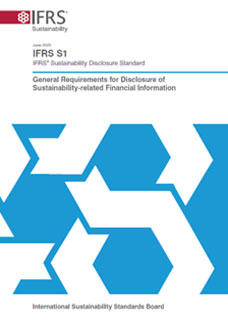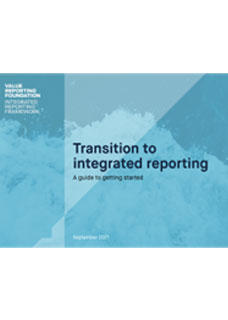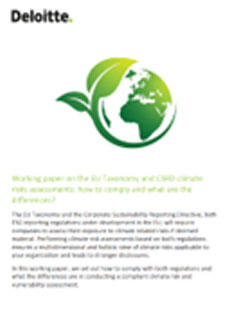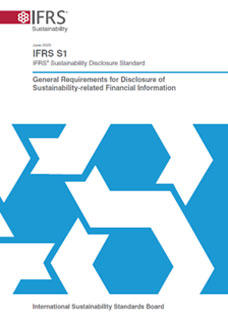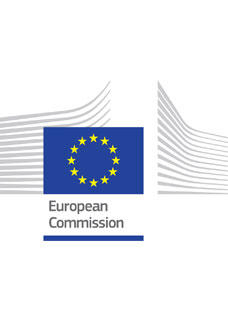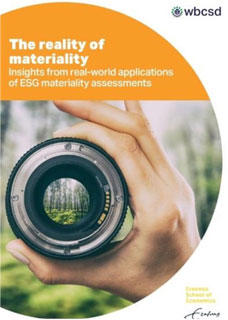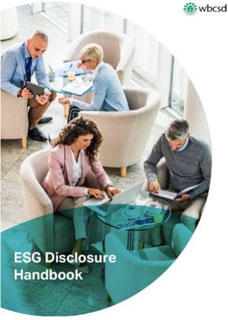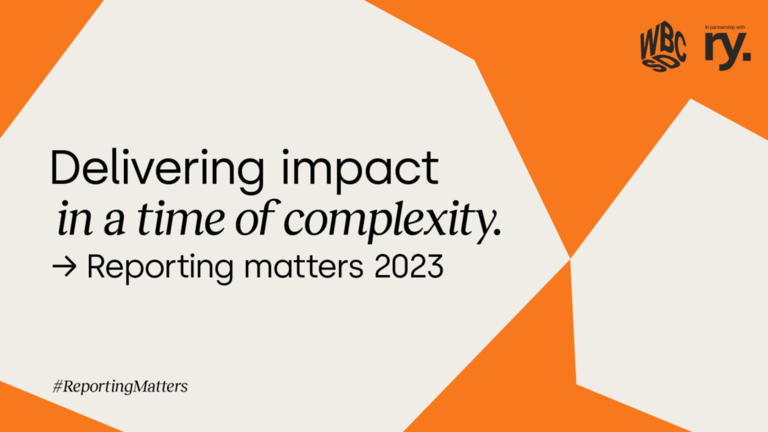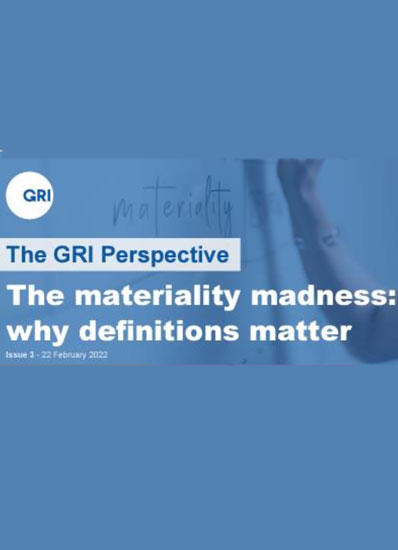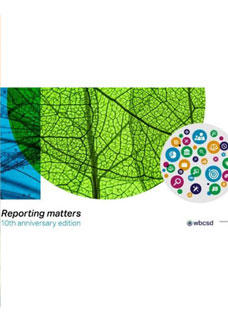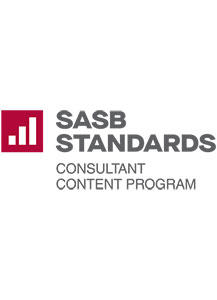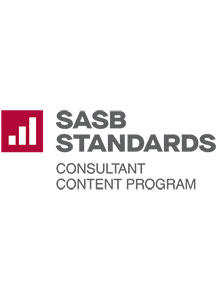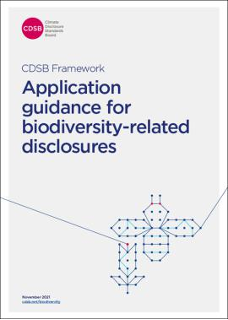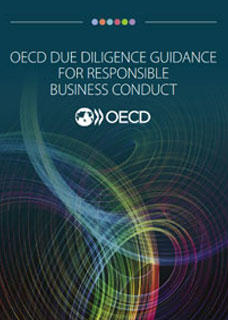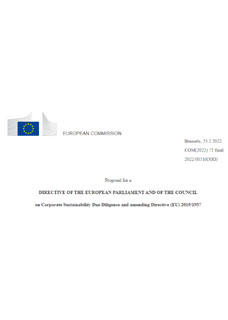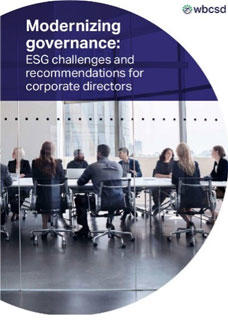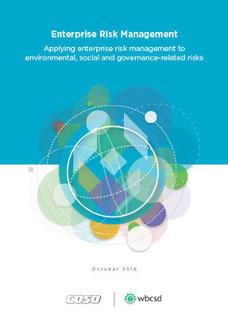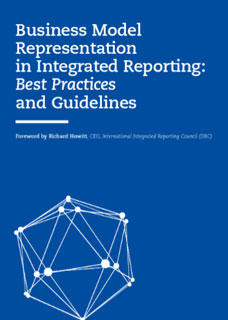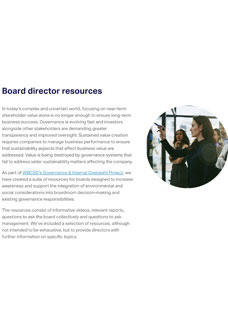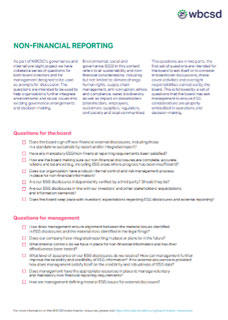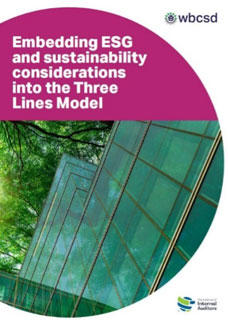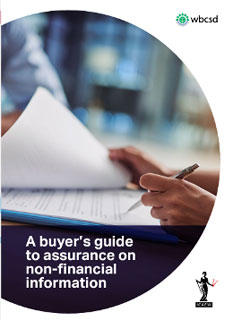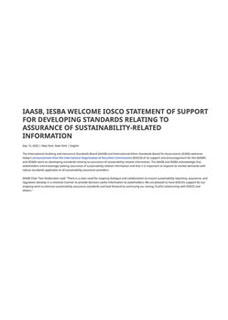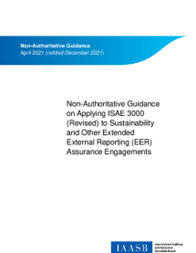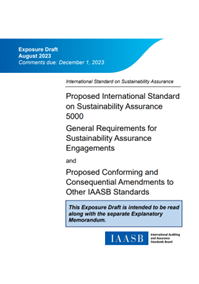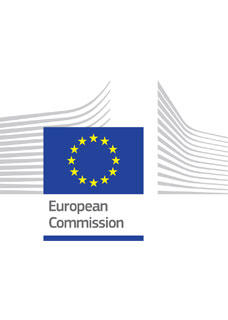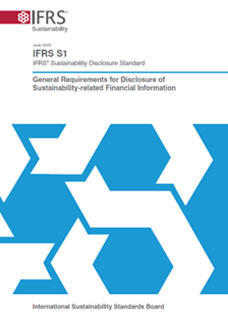WBCSD CFO Network: Implementation Guidance for the International Sustainability Standards Board (ISSB) Standards and the European Sustainability Reporting Standards (ESRS)

There is increasing demand for clear, comprehensive and comparable sustainability reporting from Financial Institutions, Regulatory Bodies, Consumers and Civil Society. Financial Institutions are increasingly looking for comparable and verified information on sustainability-related risks, opportunities, impacts and strategies to inform their assessment of long term business resilience when making investment decisions. For this reason sustainability performance and disclosure increasingly fall into the realm of the CFO and finance teams.
The purpose of this Guidance is to help CFOs and their teams prepare to implement the new sustainability reporting requirements to inform strategic decision-making on corporate sustainability performance and respond to requests from investors, banks and regulators.
The Guidance provides side-by-side analysis of two new sustainability disclosure standards that are setting the bar for sustainability reporting globally, and highlights priority issues for finance professionals identified through WBCSD’s CFO Network. The Guide focuses on:
- The IFRS S1: General Requirements for Disclosure of Sustainability-related Financial Information and IFRS S2: Climate-related Disclosures (released on 26 June 2023). These standards have been developed by the International Sustainability Standards Board (ISSB) under the International Financial Reporting Standards (IFRS). The ISSB Standards are intended to create a global baseline for sustainability disclosure by providing decision-relevant information to investors which is directly related to the financial value of the enterprise.
- The European Sustainability Reporting Standards (ESRS) ESRS 1: General Requirements and ESRS 2: General Disclosures (adopted by the European Commission on 31 July 2023). The ESRS standards, in addition to these two cross-cutting standards, include 10 topic specific standards covering environmental, social and governance disclosures. The ESRS are based on draft standards that were developed by the European Financial Reporting Advisory Group (EFRAG) to support implementation of the Corporate Sustainability Reporting Directive (CSRD). The ESRS provide a comprehensive sustainability disclosure framework for all key stakeholders – including investors, employees, civil society and beyond.
The guidance also provides consideration for companies preparing to report against the U.S. Securities and Exchange Commission (SEC) climate disclosure rule (currently awaiting release) which is also intended to inform investor decision-making and help protect investors.
Who needs to report, and when is reporting required
Main goals
The applicability of the standards will depend on each company’s specific circumstances, including the size, nature and geographical footprint of the business. Understanding which standards apply to your organization is a crucial first step to preparing for implementation.
ISSB Standards |
European Sustainability Reporting Standards |
|
As with the IFRS Accounting Standards, it is ultimately at the discretion of individual jurisdictions to mandate the use of the ISSB Standards. The ISSB is working closely with individual jurisdictions to support adoption, and to ensure compatibility and interoperability with national regulations. The International Organization of Securities Commissions (IOSCO) has endorsed the ISSB Standards and called on its 130 member jurisdictions to “consider ways in which they might adopt, apply or otherwise be informed by the ISSB Standards within the context of their jurisdictional arrangements, in a way that promotes consistent and comparable climate-related and other sustainability-related disclosures for investors”. The work of the ISSB has the support of several key stakeholders including the G7, the G20, the Financial Stability Board, African Finance Ministers, as well as from the Finance Ministers and Central Bank Governors of more than over 40 jurisdictions. This is a positive signal for their uptake as a global baseline for sustainability disclosures globally. |
The ESRS will apply to around 50,000 companies operating within the EU. This includes:
|
Special considerations for SEC filers | |||
The US SEC’s Proposed Climate rule would apply to both domestic and foreign registrants. Depending on the final rule, there may be exemptions for scope 3 emissions data for certain filers: the draft rule provided these exemptions for Smaller Reporting Companies. | |||
Preparing for implementation | |||
| |||
Finding the answers: key tools and resources | |||
| |||
|
Read IOSCO’s endorsement of the ISSB Standards. IOSCO endorsed the ISSB Standards on 25 July 2023 through this statement. |
The timelines for the standards depend on a number of factors, including the size, nature and geographical footprint of the business. Understanding when they will apply to your company is a crucial step to preparing for implementation, and managing your preparatory work for the new standards.
ISSB Standards |
European Sustainability Reporting Standards |
|
IFRS S1 and S2 standards will be applicable for the 2024 fiscal year period (reports published in 2025), but this will be dependent on the uptake of the standards by national jurisdictions. However, the ISSB has introduced a one year transition relief period for IFRS S1. This means companies will only need to apply the requirements in IFRS S1 in relation to the disclosure of climate-related financial information (in accordance with IFRS S2) for the first year of application. The transition relief also allows companies in the first year:
|
Companies covered by the CSRD will have to report against the ESRS based on the timelines outlined in the CSRD for the relevant category of companies. It will apply to:
In addition, some phase-ins have been provided to allow more time for implementation for specific elements of the ESRS. These include, for example, not having to report on the anticipated financial effects related to non-climate environmental topics and certain workforce topics in the first year. |
Special considerations for SEC filers | ||
|
The timeline for the implementation of the US SEC’s proposed climate rule varies depending on the company and disclosure in question. Per the draft rule, Large Accelerated Filers would disclose 2023 data in 2024, excluding scope 3 data, which would apply a year later. Limited assurance requirements would also apply from 2025 (covering 2024 disclosures), with these becoming reasonable assurance requirements in 2027 (covering 2026 disclosures). The timeline is pushed back for one year for accelerated filers and non-accelerated filers, with the assurance requirements not applying to non-accelerated filers. | ||
Preparing for implementation: key questions | ||
| ||
Finding the answers: key tools and resources | ||
|
|
Explore the detail of the proposed phase-ins for the ESRS Appendix C of ESRS 1 (p. 29) outlines in detail the phase-ins for the ESRS. |
How to set up reporting
Main goals
- Information quality
- Alignment with other frameworks
- Reporting boundaries and value chain reporting
- Structure and location of sustainability information
For information to be useful to key stakeholders – including business decision-makers and investors – it is crucial that companies produce high quality data, and set clear reporting boundaries. Each standard sets out specific parameters for ensuring the quality of information.
ISSB Standards |
European Sustainability Reporting Standards |
|
The ISSB Standards require the inclusion of information that would be relevant for primary users’ decision-making efforts. IFRS S1 defines fundamental characteristics for quantitative information. This information must be:
IFRS S1 requires that qualitative information be:
|
The ESRS requires information that is relevant when it could affect the decisions of multiple stakeholders. The ESRS requires qualitative and quantitative information to be:
|
Summary |
The standards are aligned on the characteristics of quality information. The main difference is that the ESRS do not specifically mention timeliness as being one of the enhancing factors, whereas the ISSB Standards do include it. |
Preparing for implementation: key questions |
|
Finding the answers: key tools and resources | ||
|
While the ISSB Standards and ESRS are newly developed, they are based on existing frameworks. Standard setters continue to work together to improve alignment and interoperability between standards. However, both the ESRS and ISSB Standards are more robust than many existing standards, and must be applied in their entirety. Building on existing disclosures will help companies implement the new standards, but companies should also carefully review the new standards and conduct a gap analysis to identify additional elements of disclosure required by the ESRS and ISSB Standards and prepare to comply.
ISSB Standards |
European Sustainability Reporting Standards |
TCFD | ||
| ||
GRI | ||
| ||
SASB | ||
| ||
OTHER STANDARDS | ||
|
Summary |
Both the ISSB and ESRS standards are built on existing frameworks. The ISSB Standards draws heavily on the TCFD and SASB standards which have a strong focus on providing information that is financially material to inform investors. The ESRS standards also draw on the structure of the TCFD. In addition they are more closely aligned with GRI which aims to provide information to a wider set of stakeholders. Companies need to carry out a detailed gap analyses to understand where their reporting against existing frameworks already helps them meet the requirements of the new disclosure frameworks, and where additional effort will be needed to comply with these requirements. |
Preparing for implementation: key questions |
|
Finding the answers: key tools and resources | ||
|
|
TCFD Recommendations and ESRS Reconciliation table EFRAG’s comparison of the ESRS and TCFD outlines where the ESRS align with the TCFD recommendations, and where the ESRS go above and beyond the TCFD recommendations. |
Comparison - [Draft] IFRS S2 Climate-related Disclosures with the TCFD Recommendations The ISSB has published a comparison of its draft climate standard with the TCFD recommendations to outline where the ISSB’s requirements are different to the guidance of the TCFD. |
Both standards require the reporting entity to be the same as for the general purpose financial statement. Companies will be required to report on activities along the value chain – both upstream and downstream. This means that companies are responsible to fairly and responsibly represent their own data, as well as the data from across their value chain.
Both standards also require companies to report on their Scope 3 Emissions which means gathering data on emissions both upstream and downstream in the value chain.
Collecting data on sustainability-related issues in the value chain is a challenge for most companies who are asking their suppliers to provide it. This effectively means that companies not covered by the CSRD may be required to collect data to comply with the ESRS disclosure requirements because they are asked to provide data to companies they supply, or buy from, who are required to report against the CSRD. Similarly companies that have not opted voluntarily to report against ISSB and are not required by national regulation to do so, may still find they need to prepare information for ISSB disclosures requested by companies in other parts of the value chain.
ISSB Standards |
European Sustainability Reporting Standards |
|
The ISSB Standards require sustainability related financial disclosures to be for the same reporting entity as its general purpose financial statements. The ISSB Standards use a broad definition of the value chain. When disclosing, companies will need to assess sustainability-related risks and opportunities related to the full range of activities, resources and relationships used and relied on from conception to end-of-life of the entity’s products or services. This ISSB requires companies to reporting on Scope 3 emissions using the Green House Gas protocol. These requirements are set out in S2 Climate-related Disclosures. The ISSB has allowed a one year transitional relief for companies to report on their scope 3 emissions when applying the standards, giving companies some extra time to implement the necessary systems to gather and report value chain-level data. |
ESRS also requires that sustainability disclosures match the boundaries of the financial statements. The ESRS defines value chain as the full range of activities or processes needed to create a product or service, including relationships upstream and downstream of its own activities. Companies are required to take the whole value chain into account when assessing sustainability impacts, risks and opportunities, and to present this information as part of their reporting. The ESRS requires companies to report on their Scope 3 emissions using the Green House Gas protocol. The ESRS is more restrictive than the ISSB because it requires companies to use the operational control method of carbon accounting. These requirements are set out in ESRS E1 Climate Change. The standards recognize that it can be difficult to gather data from the whole value chain where the entity’s level of control or influence is low, so they allow approximations when reasonable effort has been made to produce the information. In such instances, the entity has to disclose the basis for the approximation and the planned actions to reduce the level of missing data. |
Summary |
Both standards require that the reporting entity should be the same for sustainability disclosures and financial statements. Preparers will have to identify sustainability risks and opportunities across the value chain both upstream and downstream. Whilst the wording of the definition of value chain differs slightly between the IFRS and the ESRS, the practical application for boundary setting for reporting entities should be the same. The principle difference is that the ESRS also requires reporting on impacts along the value chain in addition to risks and opportunities. |
Preparing for implementation: key questions |
|
Finding the answers: key tools and resources | ||
|
|
Pathfinder Framework Version 2.0 The Partnership for Carbon Transparency (PACT)’s Pathfinder Framework to help organizations develop and exchange primary data-based product carbon footprints (PCFs). The requirements captured in it seek to further enhance data reliability and consistency across industries and value chains. |
Incentives for Scope 3 supply chain decarbonization WBCSD and PwC’s guidance on incentivizing decarbonization in the value chain assesses the different levers for incentivizing supplier decarbonization. This includes an in-depth review of how to mandate carbon reporting in the supply chain. |
|
Impact Statement Downstream – Industry-Agnostic Guidance The Value Balancing Alliance provides a three step methodology for companies to quantify their downstream value chain impacts. |
Sustainability reports exist in many different forms. To align sustainability reporting with financial reporting and bring it to the same level of quality and comparability, integrated reporting is used. This means that the sustainability report and the financial report are included in the same publication.
ISSB Standards |
European Sustainability Reporting Standards |
|
For the ISSB Standards, sustainability information needs to be included in general purpose financial reporting. However, the exact location of the information is not specified. Sustainability information could be included in management commentary, management’s discussion and analysis, operating and financial review, integrated report and strategic report. When sustainability information is included in other publications, it needs to be clearly identifiable and not obscured by additional information. When information is available under the same terms and at the time as the general purpose financial reporting, cross-referencing is allowed. However, the cross-referenced information should also comply with the ISSB Standards. If information is included by cross-reference, the body or individuals that authorize the use of the information take the same responsibility as for the information directly included. The reference needs to state the location, including a specific part of the location where the information can be found and how to access it. Duplication of information should be avoided. The ISSB has agreed a one year transitional relief for companies to provide annual sustainability-related disclosures at the same time as the related financial statements. |
For the ESRS, sustainability information needs to be included in a dedicated section of the management report and identified as “the sustainability statements". The sustainability statements consist of four parts: general, environmental, social and governance information. Companies need to follow this order, but the standards allow for cross-referencing to avoid duplication of information. In addition, other references may be used across financial statements, other reports (corporate governance report, remuneration report or other obligated public disclosures by European legislation), but only if they are:
EU Taxonomy disclosures must also be included in the sustainability statements and identified as such. Additional disclosures, coming from local legislations and other sustainability reporting frameworks (such as ISSB and GRI), may be included in the sustainability statements, next to ESRS requirements and should be clearly identified and referenced. |
Summary |
|
The ESRS are more strict in the structure and location of the sustainability information. Where the ISSB Standards only requests that the information is included in the same publication as the general purpose financial reporting, the ESRS requires it to be included in the management report and follow a pre-specified structure: first general, then environmental, next social and last governance information. References are allowed under both frameworks, under some conditions, and inclusion of other information is also allowed, when clearly identified. |
Preparing for implementation: key questions |
|
Finding the answers: key tools and resources | ||
|
|
Identifying what to report

Main goals
Materiality and the materiality assessment process are vital for companies to effectively identify, manage and report on significant ESG risks and opportunities. Materiality is defined at the high level in the standards. Companies are then required exercise judgement about what information is relevant for decision-making and how they determine this. The ISSB Standards and the ESRS take different approaches to materiality.
ISSB Standards |
European Sustainability Reporting Standards |
|
The ISSB Standards are specifically focused on information that is useful to the investor and defines information users as “the primary users of general purpose financial reports.” As a result, all of the information required under the ISSB Standards directly links to the financial performance of the company. Under the ISSB Standards, companies are required to report on any information that would reasonably affect an investor’s decision-making. In other words, information is material when omitting or misconstruing the data would likely result in an investor making a different decision. Companies are not required to disclose information that is not material for the company and no thresholds for materiality are specified that would predetermine what information would be considered material in a particular situation. Instead, companies are required to apply judgement to identify material sustainability-related financial information. Companies must also disclose how those assessments were conducted. Materiality judgements will need to be reassessed at each reporting date. |
The ESRS take a double materiality approach in order to meet the requirements of a wide range of stakeholders. This means that information disclosed under ESRS is designed to illustrate potential financial impacts on a company (financial materiality), but also impacts on the environment and society (impact materiality). Because the ESRS are designed to provide information to a wide variety of stakeholder groups (from investors to civil society), the audience also includes everyone that might be affected (positively and negatively) by the actions of the company across its value chain. The ESRS requires companies to apply a double materiality lens which means they must report information that has financial materiality OR impact materiality for stakeholders. This means the materiality analysis must cover issues that have impact materiality even if they are not financially material and vice versa. This should encourage companies to identify issues which may become financially material in the future and to incorporate these into their strategy. Within the ESRS, only ESRS 2: General Disclosures is mandatory for all companies. The other topical standards are mandatory if they are deemed material as a result of the company's materiality assessment. If a company’s materiality assessment concludes that climate change is not a material topic, meaning the company will not report in line with ESRS E1 Climate Change, the company must provide a detailed explanation of the conclusions of its materiality assessment in relation to climate change. If a company determines that data points deriving from other relevant European legislation (e.g. SFDR) is not material, they should also provide a table stating the relevant data points. |
Summary |
|
Both the ISSB and ESRS use materiality as the basis for creating the sustainability report. But as the intended audiences for the ISSB Standards and the ESRS are different, the methods for determining the required topics will be different. The principal audience for the ISSB report is the investor, whereas in the ESRS, the audience is defined as 'affected stakeholders', which means anyone who could be affected (positively and negatively) by the actions of the company across its value chain. Companies are required to conduct materiality assessments, and report on the findings. Companies must use their own judgement to identify material sustainability-related information, i.e. information that would reasonable affect the decision-making of the target audience (investors and/or all stakeholders). Companies are required to disclose the process they used to conduct their materiality assessment and should be prepared to disclose why they have considered some issues are not material as this is essential information for stakeholders to understand the completeness and credibility of the materiality assessment. |
Special considerations for SEC filers |
Companies disclosing under the US SEC and who produce regulatory filings such as the 10-K or 10-Q are already listing and describing material information on risk factors. Companies filing in the United States that also need to comply with the ISSB Standards or ESRS should include the ESG topics covered in the ESRS and ISSB Standards in their integrated risk assessments. This will help ensure alignment between ISSB, ESRS and US SEC disclosures and the processes to meet them. Some topics included under the ISSB Standards and ESRS may not meet the SEC’s risk threshold, but appropriate disclosures may still need to be made to meet the requirements of the global or European standards. |
Preparing for implementation: key questions |
|
Finding the answers: key tools and resources |
|
Read the ISSB Standards section on materiality Paragraphs 17-19 and B13-B18 of Appendix B the IFRS S1 standard include detailed information on its definition of materiality and how materiality applies in the ISSB Standards. |
Read the ESRS’ section on materiality Section 3 of ESRS 1 (p.5) outlines the double materiality principle in detail. |
|
Understand your materiality assessment process Companies who need to understand different approaches to materiality, and how to develop their internal processes and external disclosure should explore “The Reality of Materiality: Insights from real-world applications of ESG materiality assessments” |
How to use the materiality assessment process to inform your report For detailed information on how materiality assessments can be used to determine what and how much information to include in the sustainability/ESG report, please visit the ESG Disclosure Handbook’s dedicated section on materiality. |
|
Follow best practice guidance for a robust materiality assessment process Visit Reporting Matters for insight into market tracking on the most common material issues amongst leading companies, as well as key principles for robust disclosure for your materiality assessment. These include descriptions of the process, prioritization, outcomes and alignment with strategy – among others. |
Get a grip on the context Understanding the differences between impact, financial & double materiality will help you will help you develop your materiality assessment to ensure it serves your reporting and wider strategic needs. |
Conveying entity-specific sustainability-related risks and opportunities is the main purpose of the report and are the ideal outcome of a robust materiality process. Use your materiality assessment process to identify risks and opportunities. Each standard classifies risks and opportunities slightly differently.
ISSB Standards |
European Sustainability Reporting Standards |
|
For the ISSB Standards the basis of the report is sustainability-related risks and opportunities. Companies are asked to describe risks and opportunities over the short-, medium- and long-term, and to clearly define what these time horizons mean for the company. The standards also request information about the input parameters used and how risks and opportunities are monitored and managed. In addition, companies should consider the SASB industry-specific standards to identify sustainability-related risks and opportunities. They can also make reference to wider standards when doing so (e.g. CDSB, other standards focused on financial materiality, and peer and geographic benchmarks). Companies are also required to disclose the anticipated effect that the identified risks and opportunities could have across the value chain and where the effect is concentrated (geographical, facilities, assets, inputs, outputs, distribution channel, etc.). Companies are exempt from disclosing commercially sensitive information about a sustainability-related opportunity, but will have to disclose that they are using this exemption. The exemption cannot be used on a broad basis to avoid disclosure. Disclosure on process Companies are required to disclose the process for identifying, assessing and prioritizing sustainability-related risks and opportunities. In addition, the standards require companies to explain whether and how they have integrated this process into their overall risk management framework. |
For the ESRS the basis of the report is sustainability-related risks, opportunities and impacts:
In a situation where a company’s actions to address or benefit from impacts, risks or opportunities have a material negative impact on another sustainability matter, the entity should disclose this and how it is addressed. Disclosure on process Companies are required to disclose the methodologies and assumptions applied as well as the processes to identify, assess and prioritize impacts, risks and opportunities that (may) have financial effects. The standards also require that companies disclose how they determine what information is material. Companies will need to provide information on their internal decision-making and internal control processes, and the extent to which sustainability-related impacts, risks and opportunities are included in the overall risk management process. Any changes in the processes compared to the prior period need to be disclosed, as well as any modifications or future revision dates to the materiality assessment. The materiality assessment process is also subject to external assurance. |
Summary |
|
Both standards require companies to disclose on sustainability-related risks and opportunities, but the ESRS also requires disclosure on sustainability-related impacts. The ISSB explicitly allows companies not to disclose commercially sensitive information related to sustainability opportunities. Both standards require companies to report on the process for identifying sustainability risks and opportunities and how these processes are integrated into their overall risk management approach. |
Preparing for implementation: key questions |
|
Finding the answers: key tools and resources |
|
Read the ISSB Standards section on risks and opportunities Paragraphs 30-31 and B19-B28 of Appendix B of the IFRS S1 standard include detailed information on how risks and opportunities should be considered when applying the standards. |
Read the ESRS’ section on materiality Section 4 of ESRS 2 (p.47) includes detailed information on the identification and disclosure of impacts, risks and opportunities. |
|
Understand your materiality assessment process Companies who need to understand different approaches to materiality, and how to develop their internal processes and external disclosure should explore “The Reality of Materiality: Insights from real-world applications of ESG materiality assessments” |
How to use the materiality assessment process to inform your report For detailed information on how materiality assessments can be used to determine what and how much information to include in the sustainability/ESG report, please visit the ESG Disclosure Handbook’s dedicated section on materiality. |
|
Follow best practice guidance for a robust materiality assessment process Visit Reporting Matters for insight into market tracking on the most common material issues amongst leading companies (p. 16), as well as key principles for robust disclosure for your materiality assessment (p. 28). These include descriptions of the process, prioritization, outcomes and alignment with strategy – among others. |
Get a grip on the context Understanding the differences between impact, financial and double materiality will help you develop your materiality assessment to ensure it serves your reporting and wider strategic needs. |
|
SASB Materiality Map and Standards The SASB Standards identify the financially material topics across 77 industries most relevant to financial performance in each of 77 industries. They are designed to help companies disclose financially-material sustainability information to investors. The SASB Materiality Map looks at how 26 sustainability topics manifest across the 77 topics. |
Metrics in financial reporting are relatively well-developed. However, metrics used in sustainability reporting and across different companies can vary widely, in part due to a lack of standardization globally. Setting targets and metrics for corporate sustainability performance that capture an organization’s unique impact and strategy, while also providing stakeholders with relevant information, is often difficult to do. Both the ISSB Standards and the ESRS outline how to define metrics so that report users have the information they need.
ISSB Standards |
European Sustainability Reporting Standards |
|
Metrics and targets are defined in the ISSB Standards as information used to assess, manage and monitor the entity’s performance in relation to sustainability-related risks and opportunities over time. An entity should disclose the metrics it uses to:
Metrics For Metrics and targets the ISSB requires that companies:
For each metric, the following should be provided:
Targets For each target, the following should be provided:
The ISSB Standards emphasize the importance of the consistency in definitions and calculations of metrics and targets. If they are redefined or replaced, this needs to be explained (why is the replacement metric an improvement) and where practicable, restated comparative figures need to be provided. |
In accordance with the ESRS, metrics are used to evaluate performance and to track effectiveness of its actions to manage material sustainability matters (impacts, risks and opportunities). Metrics For metrics, the ESRS requires that companies:
Targets For targets, the ESRS requires that companies:
For each target the company should:
The ESRS topic specific standards can be highly prescriptive on the nature of certain targets. For example,
If no targets are adopted to certain sustainability matters, the entity should disclose the reason for not having adopted targets, and outline how it is tracking progress, as well as describing the timeframe for targets to be developed or why no targets will be adopted. |
Summary |
|
Both frameworks have similar disclosure requirements regarding the quality and description of metrics and targets. Both standards require companies to disclose information on the definition and scope of metrics and targets and on the process that was used to define them . Both standards also require companies to explain any changes in metrics and targets and how these will affect the comparability of information However the ESRS has additional requirements compared to the ISSB Standards. The biggest differences are:
The ESRS requires companies to disclose on the involvement of stakeholders in setting the targets which is not required by the ISSB Standards. |
Preparing for implementation: key questions |
|
Finding the answers: key tools and resources |
|
Read the ISSB Standards section on metrics and targets Paragraphs 45-53 of the IFRS S1 standard include detailed information on the metrics and target disclosure requirements when applying the standards. |
Understand the ESRS’ approach to disclosures on metrics and targets. Section 5 of ESRS 2 (p.50) outlines the minimum disclosure requirements in relation to metrics and targets. |
|
Find market performance on measurements and target setting Recommendation from Reporting Matters is that every material topic should have one of multiple SMART targets that show progress towards the overall strategy for that material topic. Additionally, companies are recommended to disclose performance against those SMART targets on an annual basis and provide historical context. |
SASB Standards The SASB Standards are a key point of reference for identifying relevant metrics for the ISSB Standards. They cover financially material topics across 77 industries. The ISSB is undertaking a process to update the SASB standards to improve their international applicability in the coming years. |
|
CDSB Framework application guidance for water- and biodiversity-related disclosures The CDSB’s guidance for water- and biodiversity- related disclosures is a key reference for entities seeking to make relevant disclosures in line with the ISSB Standards. |
ESRS topic-specific standards The first set of the ESRS include 10 topic-specific standards, which outline relevant disclosure metrics. These cover five environmental, four social and one governance topic. |
Due diligence is a very broad topic, which most companies have included in their internal policies but not tended to make extensive external disclosure on.
ISSB Standards |
European Sustainability Reporting Standards |
Due diligence is not explicitly mentioned in the ISSB Standards. |
The ESRS defines sustainability due diligence as: “ the process by which undertakings identify, prevent, mitigate and account for how they address the actual and potential negative impacts on the environment and people connected with their business.” The ESRS do not impose any conduct requirements in relation to sustainability due diligence; nor do they extend or modify the role of administrative, management or supervisory bodies. However, On 1 June 2023, the European Parliament agreed on its position on the Directive on corporate sustainability due diligence (the CSDDD). The CSDDD requires in-scope companies to conduct due diligence on, and take responsibility for, human rights abuses and environmental harm throughout their global value chains. The formal adoption of the CSDDD will significantly expand the requirements on companies operating in Europe to conduct human rights and environmental due diligence throughout their value chains, and make associated disclosures on the policy, process and outcomes of such activities. ESRS describes the due diligence process as input for the materiality assessment, in particular in relation to understanding impact materiality. Where the undertaking cannot address all impacts at once, the due diligence process allows for action to be prioritized based on the severity and likelihood of the impacts. Due diligence processes are incorporated in various disclosure requirements within the ESRS including:
|
Summary |
ISSB Standards do not specifically mention due diligence however the ESRS do incorporate it. Due diligence, is define in the ESRS d as “ the process by which undertakings identify, prevent, mitigate and account for how they address the actual and potential negative impacts on the environment and people connected with their business.” Due diligence processes are therefore built into disclosure requirements focusing on the identification and management of impacts on people and the environment. |
Preparing for implementation: key questions |
|
Finding the answers: key tools and resources |
|
Understand the ESRS’ approach to due diligence Section 4 of ESRS 1 (p.9) outlines the due diligence requirements when applying the standards. |
Find global leading due diligence guidance The OECD due diligence guidance for responsible business conduct proposes the following steps to take:
|
|
Europe is developing regulation on due diligence disclosures While this regulation is still under development, it is good to get up to date on what is coming. Find the proposal here: Proposal for a Directive on corporate sustainability due diligence and annex | European Commission (europa.eu)
|
Obtain the insights to develop due diligence procedures Sustained value creation requires companies to manage business performance to ensure that sustainability matters that affect business value are addressed. By addressing emerging and increasingly relevant impacts and dependencies, boards are better equipped to make informed decisions about strategy and to provide robust oversight while delivering on their fiduciary duties. Modernizing governance: key recommendations for boards to ensure business resilience - World Business Council for Sustainable Development (WBCSD) |
|
Information on the proposal for a Directive on corporate sustainability due diligence For information on this proposal, visit this link. |
How to report on business impacts

Main goals
Typically, strategy disclosures are designed to draw out information on potential sustainability impacts, risks and opportunities may have on a company’s strategic and financial planning. The ISSB Standards and ESRS require a qualitative description of how sustainability affects the strategy and business model.
ISSB Standards |
European Sustainability Reporting Standards |
|
The ISSB Standards are designed to help investors (primary users) understand how sustainability-related financial risks and opportunities could affect:
|
ESRS requires companies to describe the strategy and business model more generally – and not just how it relates to sustainability. Using this context, a company will be required to describe the interaction between the strategy, business model and sustainability. For example, for each material topic, the company will need to answer the following questions:
The phase-in allowances of the ESRS mean that companies are exempt from reporting on the anticipated financial effects related to non-climate environmental issues (pollution, water, biodiversity, and resource use) for the first year of implementation of the standards. They will also be allowed to use qualitative disclosures for the first three years. |
Summary |
The purpose of sustainability reporting is to inform investors and other key stakeholders, but it’s also a critical tool to help companies think about how they make decisions internally – and about the sustainability of their business models. Both frameworks will require a qualitative description of how sustainability affects the strategy and business model. While the ISSB Standards are designed to help investors understand how sustainability related risks and opportunities could financially impact a company’s strategy and business model, the ESRS requires companies to consider all impacts on strategy and business models and how key stakeholders (beyond investors) are considered in the strategy. |
Special considerations for SEC filers |
The proposed climate rule would require companies to disclose how any climate-related risks identified have had or are likely to have a material impact on its business and consolidated financial statements, which may manifest over the short-, medium-, or long-term as well as how any identified climate-related risks have affected or are likely to affect the registrant’s strategy, business model, and outlook. |
Preparing for implementation: key questions |
|
Finding the answers: key tools and resources | ||
| ||
|
Governance disclosures in sustainability reporting aim to convey information on how management and oversight bodies consider sustainability in their decision making.
ISSB Standards |
European Sustainability Reporting Standards |
|
The ISSB Standards are seeking to enable users of general purpose financial reporting to understand the governance bodies, processes, controls and procedures used to monitor and manage sustainability-related risks and opportunities. Main disclosures include:
|
The ESRS require a description of the roles and responsibilities of the governance bodies and management regarding sustainability. Specifically, this includes:
|
Summary |
The requirements under ISSB and ESRS are similar regarding disclosures on governance. The main disclosures focus on the roles and responsibilities for sustainability decision-making and oversight at Board level and at management level, the skills and competencies of those responsible for sustainability governance, how and how often the governance bodies are informed about and consider sustainability issues, and the link between sustainability and performance incentives including remuneration. |
Special considerations for SEC filers |
The proposed climate rule would include a requirement to disclose on the oversight and governance of climate-related risks by the company’s board and management teams. This would include information on the board committee responsible, relevant expertise of board members, the process and frequency through which the board discuss climate-related risks, and how these are considered as part of business strategy, risk management and financial oversight, as well as the board’s role in setting and reviewing progress on targets. For the management team, the proposed rule would include requirements to understand how and who is involved in the assessment and management of climate risk, processes to ensure management is informed of and monitors climate risk, and how management feeds this information to the board. |
Preparing for implementation: key questions |
|
Finding the answers: key tools and resources | ||
|
How to ensure credible disclosures

Main goals
Assurance enhances credibility and trust in the sustainability information that companies disclose in their corporate reports. Assurance helps practitioners, companies, investors and others have greater confidence in sustainability information so that stakeholders can rely on it for decision-making. The scope of assurance is either determined by the company (voluntary) or by regulation (legal requirement). While the ISSB Standards do not require assurance, the CSRD requires limited assurance in line with the ESRS: this is expected to evolve to reasonable assurance over time.
There are two types of assurance for sustainability information: limited assurance and reasonable assurance. The ICAEW explains the difference as follows:
- “The conclusion in a limited assurance engagement is accordingly framed in a negative sense: "Based on the procedures performed, nothing came to our attention to indicate that the management assertion on XYZ is materially misstated."
- In contrast with a reasonable assurance conclusion which would be formed in a positive sense, i.e.: "Based on the procedures performed, in our opinion, the management assertion on XYZ is reasonably stated".
ISSB Standards |
European Sustainability Reporting Standards |
|
While the ISSB Standards do not explicitly require assurance, numerous jurisdictions may require external assurance of the sustainability information once standards are adopted. The ISSB Standards are designed to facilitate third-party verification. Verifiability is included in the qualitative characteristics of useful sustainability-related financial information in the ISSB Standards. |
Requirements for assurance are included in the directive (CSRD). The directive aims to put sustainability reporting in line with financial reporting and recognizes the need for (reasonable) assurance to achieve this goal. However, because there is not yet a sustainability assurance standard, the CSRD first mandates limited assurance to be implemented by member states. The full report is in scope for assurance and the assurer would need to verify alignment with ESRS. There is ambition to move towards reasonable assurance in the near future, which will be evaluated a couple of years after implementation of the standards to better understand its feasibility. |
Summary |
Both standards have been developed to serve as a framework that will allow assurance providers to verify disclosures. While the ISSB does not require third-party assurance itself (though national jurisdictions may do so in their uptake of the standards), the ESRS requires limited assurance, with a view to reasonable assurance within a few years, once the feasibility of this is better understood. |
Special considerations for SEC filers |
The proposed SEC rule includes assurance requirements. Accelerated and large accelerated filers would have to instruct an assurance provider to review their scopes 1 and 2 emissions data. This will initially cover limited assurance, but could extend to reasonable assurance. There is expected to be a phase-in of the effective date for the assurance requirements under the SEC’s rule. |
Preparing for implementation: key questions |
|
Finding the answers: key tools and resources |
|
Follow best practice guidance for assuring sustainability information The final chapter of COSO’s guidance for applying ERM to ESG related risks and opportunities focuses on communication and reporting – and includes independent verification, assurance over sustainability information. |
Involve your internal audit by using the IIA’s three lines business model The three lines model establishes three essential roles that define governance at the foundation level: accountability, actions, and assurance. Assurance is independent from the governing body and management - it assures the reliability of internal control processes for ESG data disclosure and reporting. |
|
Understand: what is assurance, how does it work, and how does it help information users? Read the Buyers Guide to Assurance for practical guidance (pg 26), considerations and tips to help assess whether assurance is the right service to meet your needs and to identify and procure assurance services that are ‘fit for purpose’. |
Follow the latest developments Follow the latest developments, as IOSCO endorses IAASB’s efforts to develop sustainability assurance standards for assurance providers. |
|
Get familiar with the de-facto standard for assurance of sustainability information from IAASB that assurers are using Explore guidance for applying International Standard on Assurance Engagements 3000 (Revised), to sustainability information. The Guidance helps companies understand what assurance providers will be looking for and the necessary preconditions for assurance. It ensures that assurers are applying appropriate competence and capabilities, exercising professional skepticism and judgement, as well as more specific technical matters. |
Get familiar with the proposed International Standard on Sustainability Assurance (ISSA) 5000 The International Auditing and Assurance Standards Board has developed a proposal for a global sustainability assurance standard. The proposed standard is comprehensive, standalone, and can apply to any sustainability topic disclosed under multiple sustainability frameworks. |
Special considerations on reporting ESG data

Main goals
Providing comparative information on the previous reporting period provides important context for a variety of users. To ensure the information is truly comparative, companies are expected to gather information year-on-year in the same way, using the same definitions and including the same elements (for example, including the same business units every year). As sustainability reporting is less developed than financial reporting, this may not always be possible. There may be improvements made to definitions or data processes. When this happens, companies will need to disclose these changes.
ISSB Standards |
European Sustainability Reporting Standards |
|
In the first period of application of the ISSB Standards, comparative information is not required. After the first year, the ISSB Standards will require companies to disclose comparative information for all metrics as well as all narrative and descriptive disclosures. When a definition, estimate, or metric changes from year to year, a company will be asked to disclose this along with a description of why there’s been a change. Additionally, if data isn’t available for the prior period, the company will be required to describe why. |
In the first period of application of the ESRS, comparative information is not required. After the first year, ESRS requires comparative information for all metrics and KPIs. Comparative information will be required for all narrative and descriptive disclosures as well. For specific disclosures, the standards may require comparative information for more than one reporting period. When a change in preparation or presentation occurs, the company needs to correct the comparative information. When this is not possible, the company must disclose this fact. ESRS specifies that some standards might require more than one comparative period to be included in the report. |
Summary |
The requirements for comparative information are similar under the ISSB Standards and ESRS: during the first year, comparative information is not required. After the first year, comparative information will be required for all metrics, KPIs, narrative and descriptive disclosures. If changes occur, comparative information should also be corrected. If this is not possible, this will be disclosed by the company. |
Preparing for implementation: key questions |
|
Finding the answers: key tools and resources | ||
| ||
|
Follow best practice guidance for presenting targets, commitments and performance criteria Visit Reporting Matters for insight into the best ways to demonstrate year-on-year performance. The report holds recommendations for how to present commitments, targets, commitment and performance criteria in a way that illustrates key trends – including visual elements and a clear narrative. |
Estimations and uncertainties are inherent in non-financial reporting, especially when looking at future events. To be sure that report users understand how estimations and uncertainties are used within the report, it’s important to describe how and why certain estimations were used or why there are specific uncertainties.
ISSB Standards |
European Sustainability Reporting Standards |
|
The ISSB Standards recognize the need for using estimations in sustainability reporting – for example, when timelines are long or scenarios are changing. Under the ISSB Standards, companies are required to accurately describe and explain where and how such estimations are used. When estimates are material, companies need to describe the effects on cash flow. The range and likelihood of the possible outcomes also need to be described. |
The ESRS recognize the need for using estimations. Under ESRS, companies are required to accurately describe and explain where and how such estimations are used. ESRS specifically ask companies to disclose the impacts on people or the environment, including the range and likelihood of possible outcomes. |
Summary |
Both the ISSB Standards and the ESRS recognize the need for using estimations in disclosures. Both therefore require companies to describe and explain when and how estimations are used. Estimations are inherent in reporting about future events. When these estimates are material, the effects on the cash flow need to be described for ISSB and impacts on people and environment need to be described under ESRS. |
Preparing for implementation: key questions |
|
Finding the answers: key tools and resources | ||||
|
Even with the best intentions, reporting errors may occur. The standards describe what an entity should do in case an error is identified. Errors are omissions and misstatements arising from a failure to use, or misuse of, reliable information that was available at the time of authorization of the report and could reasonably be expected to have been obtained and considered. These include mathematical mistakes, incorrect definitions for metrics and targets, oversights, misinterpretations and fraud.
ISSB Standards |
European Sustainability Reporting Standards |
|
The ISSB standard requires companies to correct material prior period errors by restating the comparative amounts for the prior period(s) disclosed. The nature of the error should be described in the report. When impracticable to determine the effect of the error on all prior periods presented, the company must correct the error from the earliest data practicable and describe the circumstances and how and from when error has been corrected. Note that corrections of errors are different from changes in estimates; since these are approximations that may need revision as additional information becomes available. |
The ESRS requires companies to correct material prior period errors by restating the comparative amounts for the prior period(s) disclosed. The nature of the error should be described in the report. Do not use hindsight in making assumptions about what the management's assumptions would have been in a prior period. When impracticable to determine the effect of the error on all prior periods presented, correct the error from the earliest data practicable and describe the circumstances and how and from when error has been corrected. Note that corrections of errors are different from changes in estimates; estimates have to be revised as soon as additional information becomes available. |
Summary |
The standards are aligned on way on which errors in the prior reporting period should be addressed. The ESRS explicitly states companies should not try to reconstruct management assumptions from the previous period using hindsight. |
Preparing for implementation: key questions |
|
Finding the answers: key tools and resources |
|
Read the ISSB Standards section on reporting errors Paragraphs 83-86 of the IFRS S1 standards include detailed information on the reporting errors requirements when applying the standards. |
Read the ESRS’ section on reporting errors Section 7.5 of ESRS 1 (p.15) outlines the reporting errors requirements when applying the standards. |





